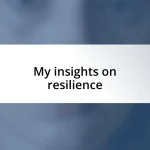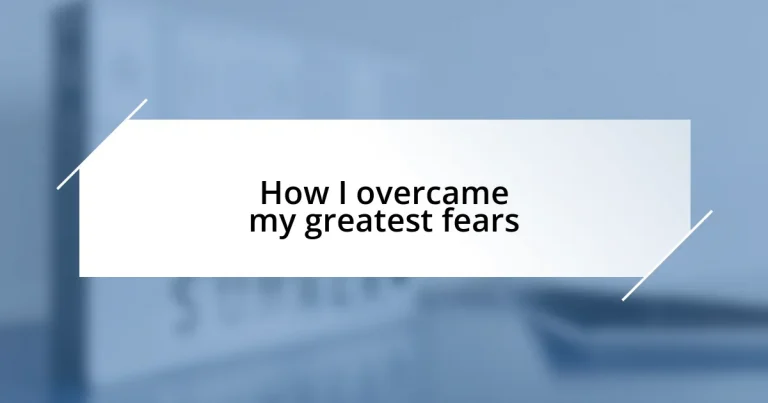Key takeaways:
- Fear often stems from past experiences and societal pressures, but understanding these roots can empower individuals to confront their fears.
- Gradual exposure, visualization, and mindfulness techniques are effective methods for managing and overcoming fears.
- Having a supportive network can significantly enhance one’s ability to face fears, providing encouragement and perspective during challenging moments.
- Documenting progress and celebrating small victories fosters motivation and resilience, transforming the journey of overcoming fears into a shared experience.
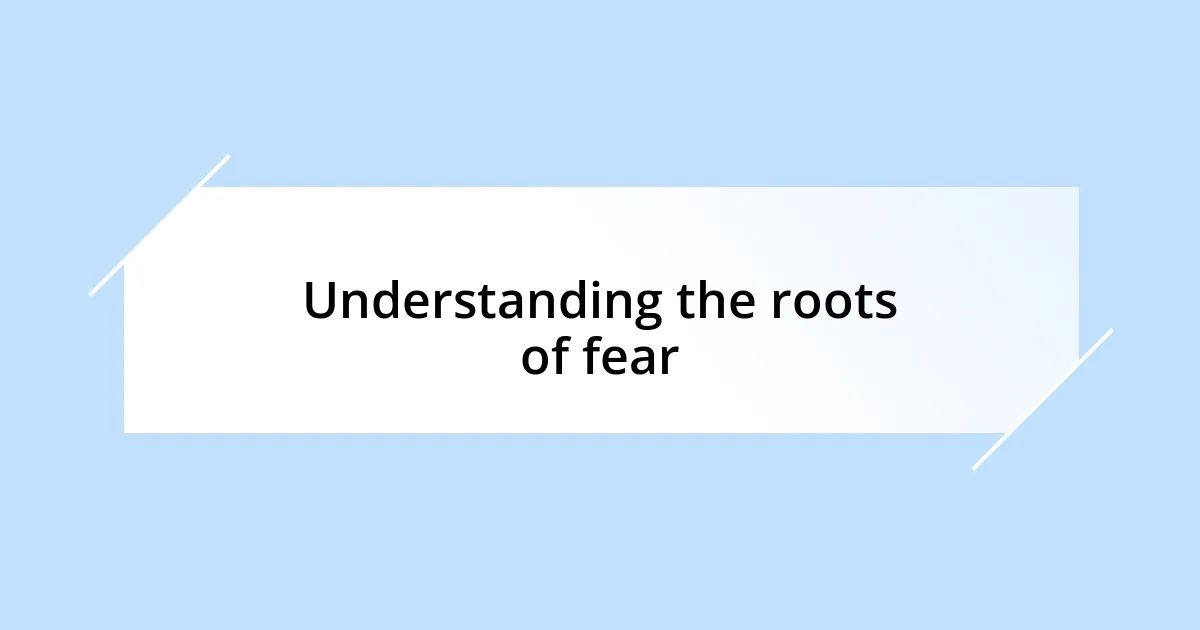
Understanding the roots of fear
Fear often roots itself in our past experiences, intertwining with our emotional responses. When I think back to my childhood, I remember vividly the first time I rode a bike and fell hard, scraping my knees. That single experience planted a seed of fear in me about trying new things—a fear that lingered longer than I’d like to admit.
Moreover, fear can be linked to societal pressures and expectations. I’ve found that often, people are afraid not just of failure but of judgment. Have you ever hesitated to share an idea, worried about how others might react? I faced that when I first shared my writing; the fear of criticism was paralyzing but also a huge catalyst for my growth.
Digging deeper, I’ve realized that our fears can transform over time. What once terrified me—like public speaking—has become an avenue of self-expression. Isn’t it fascinating how confronting those fears can reveal patterns? Understanding these roots has not only given me clarity but also empowered me to face my fears head-on, turning them into a source of strength.
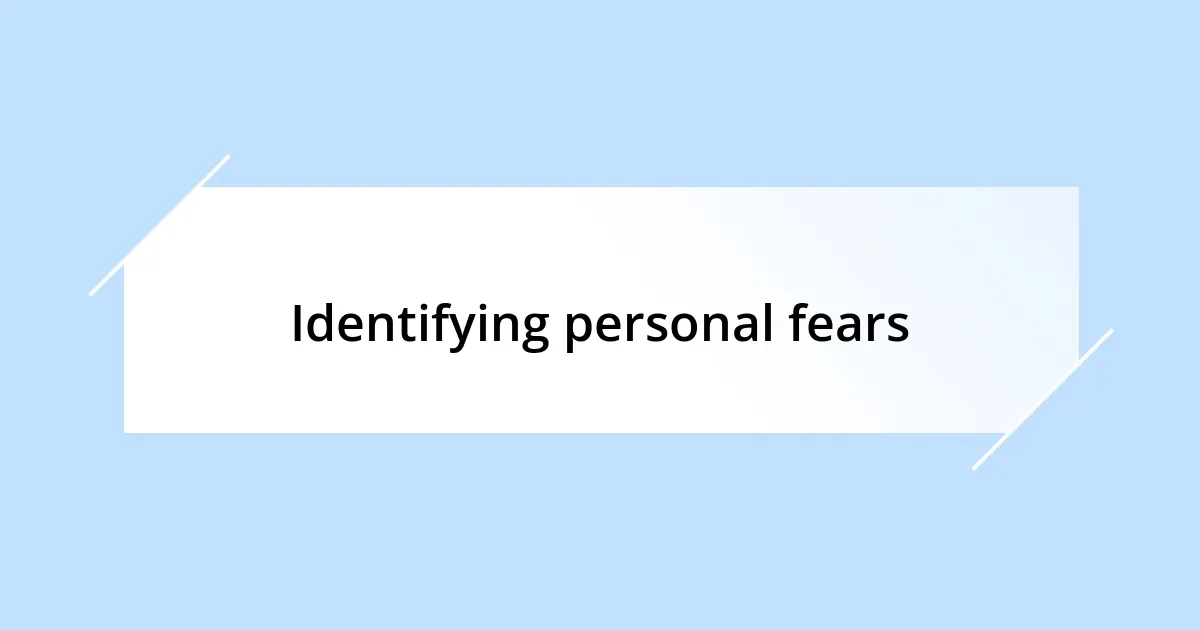
Identifying personal fears
Recognizing our fears is a significant step toward overcoming them. I remember a time when I was terrified of speaking in front of people. I thought I might choke on my words or, even worse, embarrass myself. This fear wasn’t just about speaking; it seeped into how I approached group discussions and even social gatherings. Only after reflecting on these moments did I realize that my anxiety stemmed from a deep-seated fear of rejection.
To pinpoint your personal fears more effectively, consider these questions:
– What situations make me feel anxious or uncomfortable?
– Are there specific themes or patterns in my fears—like fear of failure, rejection, or the unknown?
– Can I trace these fears back to particular experiences or influences in my life?
– How do I react physically when I encounter fear? What signs does my body give me?
– Am I avoiding certain activities or conversations because of my fears?
By truly understanding what scares us, we can begin to unpack those layers and take the necessary steps toward change. Each insight is like a piece of a puzzle that helps create a clearer picture of who we are and what holds us back.
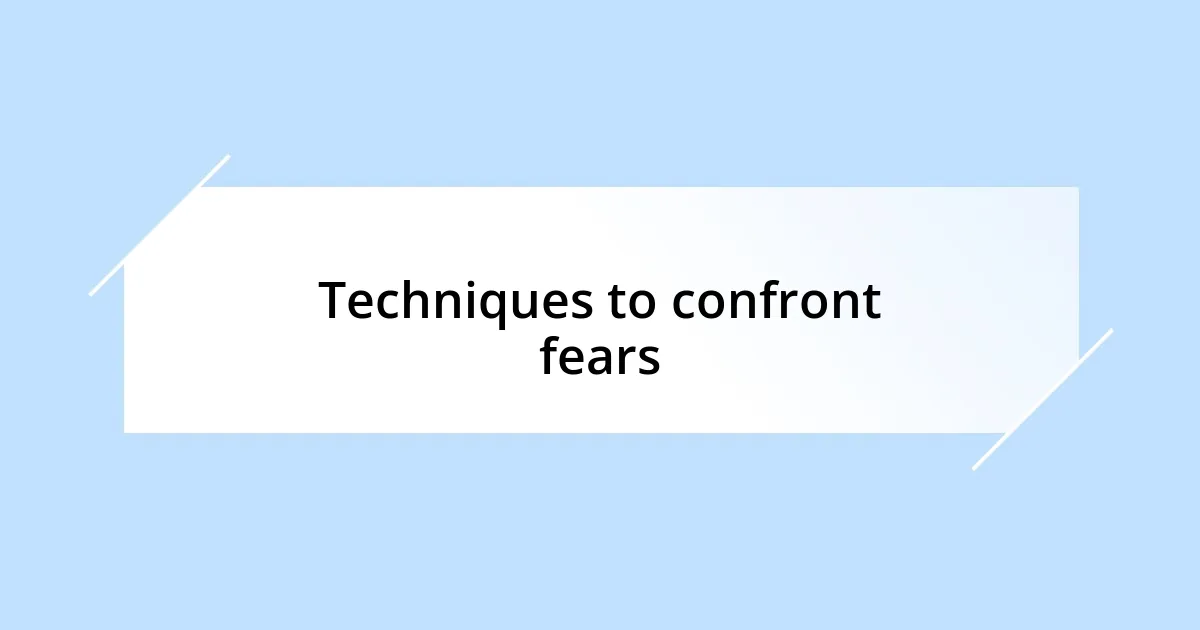
Techniques to confront fears
When it comes to confronting fears, one of the most powerful techniques I’ve used is gradual exposure. Think of it as dipping your toes into a pool rather than jumping in completely. For example, when I feared social situations, I started by simply attending small gatherings where I knew at least one person. This approach allowed me to build comfort and confidence incrementally, rather than overwhelming myself all at once.
Another effective method is visualization. I often picture myself succeeding in the situations that frighten me the most. I vividly recall preparing for a big presentation; I sat quietly, visualizing every detail—how I would speak, the audience’s smiles, and the positive feedback. This mental rehearsal helped ease my anxiety significantly. Have you ever tried visualizing yourself overcoming your fears? It’s like giving your mind a dress rehearsal before the real performance.
Lastly, I’ve found that deep breathing and mindfulness can greatly reduce the immediate physical responses to fear. One evening, sitting in my favorite cozy chair, I practiced focused breathing, inhaling for four counts, holding for four, and exhaling for six. It was remarkable how this simple practice could calm my racing heart and quiet those nagging thoughts that threatened to take over my mind. I encourage you to try it the next time fear creeps in—simply pausing can create a powerful space for change.
| Technique | Description |
|---|---|
| Gradual Exposure | Diving into fear slowly by starting with manageable situations. |
| Visualization | Picturing successful outcomes to build confidence before facing fears. |
| Deep Breathing & Mindfulness | Using breath control to calm physical responses to fear. |
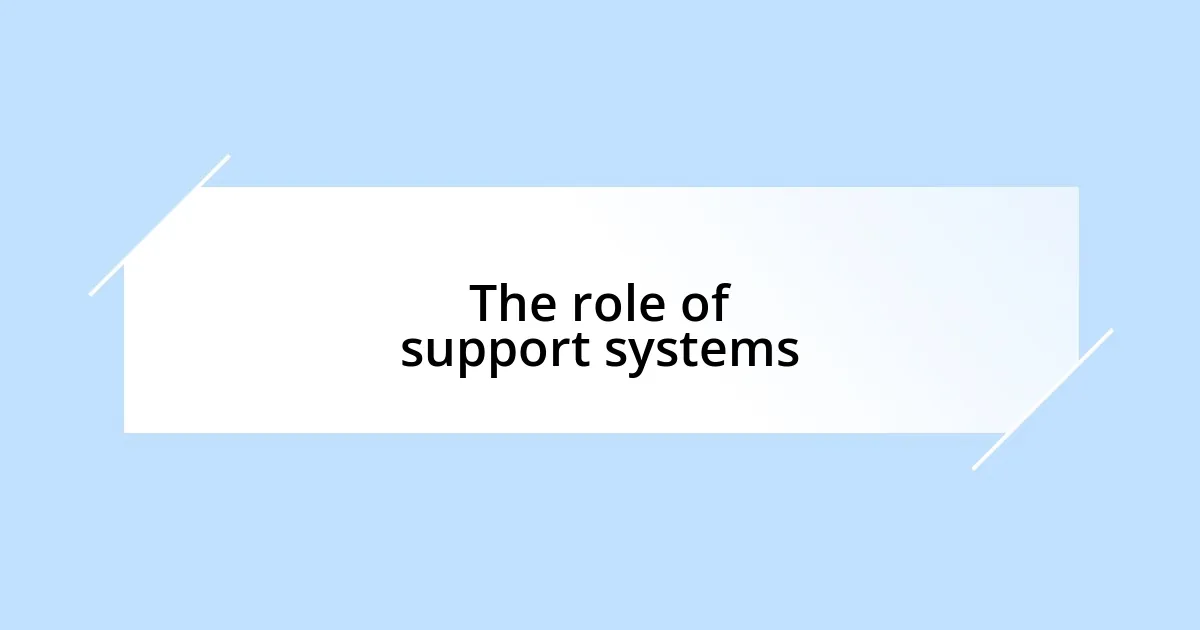
The role of support systems
When I faced my fear of public speaking, having a strong support system was crucial. I vividly remember my best friend sitting in the front row during my first speech, giving me encouraging nods the entire time. Their presence reminded me that I wasn’t alone in that moment, and it turned a daunting experience into something manageable. Just knowing someone believed in me made all the difference—have you ever leaned on someone who lifted your spirits in a challenging situation?
Support systems also serve as a sounding board for our worries. I often shared my anxieties with close family members who offered valuable perspectives. For instance, my sister reminded me that everyone in the audience had likely faced similar fears at some point. Hearing this shifted my mindset and made the situation seem less intimidating. It’s amazing how a simple conversation can transform our perception of fear, don’t you think?
In my journey, I discovered that accountability is another vital aspect of support. When I decided to join a public speaking group, the members quickly became my cheerleaders. They celebrated small victories and provided constructive feedback, which fostered my growth. This collective encouragement transformed what used to be a solitary struggle into a shared experience, demonstrating that no one has to face their fears alone. How has your support system influenced your battles with fear?

Developing a plan for exposure
Developing a plan for exposure requires careful consideration and reflection. I remember when I first tackled my fear of heights. I didn’t just jump to the top of a tall building; instead, I mapped out a series of steps. I started by visiting a park with a small hill, gradually working my way to a high-rise viewing platform after weeks of small gains. This systematic approach made the daunting feel achievable.
Details matter when embarking on an exposure plan. I took the time to write down my fears, breaking them into smaller, manageable parts. For instance, rather than saying, “I fear flying,” I identified specific aspects like boarding the plane or the turbulence during flight. Each part became a mini-goal. Have you ever felt the relief that comes from demystifying your fears? It’s like shedding a layer of weight, making the challenge seem lighter.
Monitoring progress is key to maintaining motivation. I kept a journal, documenting each experience and how I felt afterward. I still remember the thrill of checking off each small achievement; it wasn’t just about facing my fears but celebrating the journey as well. Did you know that reflecting on successes can actually reinforce your commitment to overcoming fears? It’s a simple yet powerful practice that keeps the momentum going.
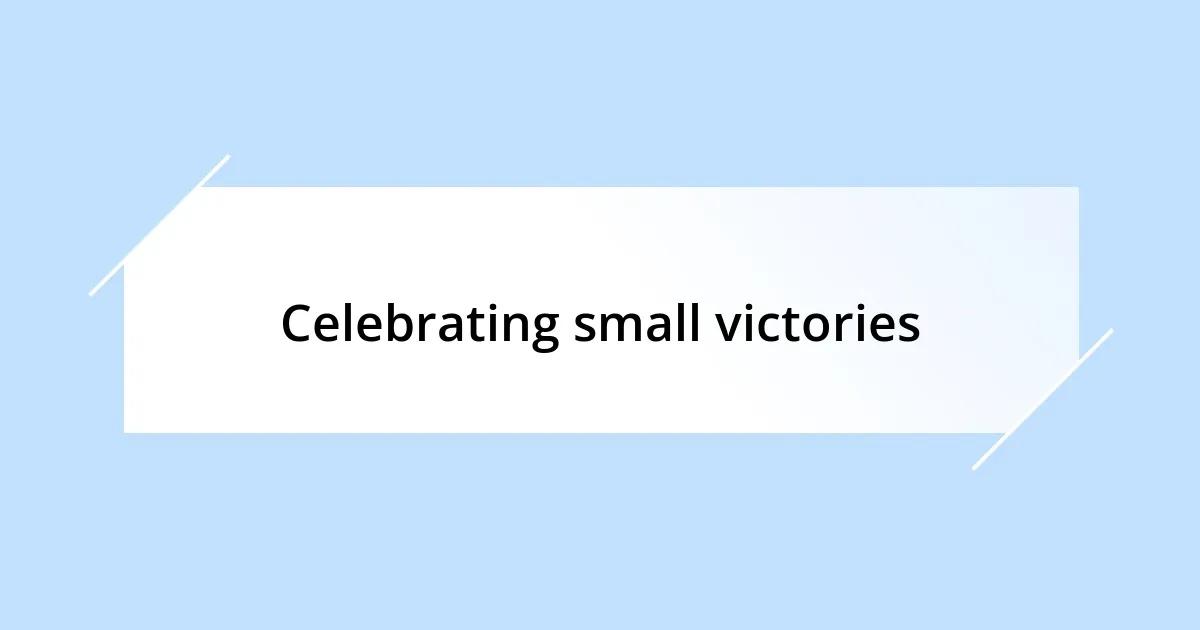
Celebrating small victories
There’s something incredibly uplifting about celebrating small victories. I recall one instance when I managed to speak in front of a small group for the first time—nothing extravagant, just a few colleagues sharing ideas. The feeling I experienced afterward was electric, as if I’d just scaled a mountain. It made me realize that even the tiniest achievement deserves recognition, don’t you think?
I also found that sharing these little wins with my support system amplified their significance. After I completed a presentation without stumbling over my words, I texted my friend about it. The enthusiastic reply I received just filled me with joy and validation. I learned that acknowledging these moments not only boosts our confidence but also creates a sense of connection. Have you ever noticed how sharing a success can enhance the experience?
Lastly, I discovered that keeping a “victory log” helped me stay mindful of my progress. I started jotting down every small step I took towards overcoming my fears. The act of writing it down made each victory feel even more tangible and real to me. Seeing my collection of accomplishments made me proud and motivated to keep pushing myself. Isn’t it fascinating how documenting our journey can transform our perspective on fear?
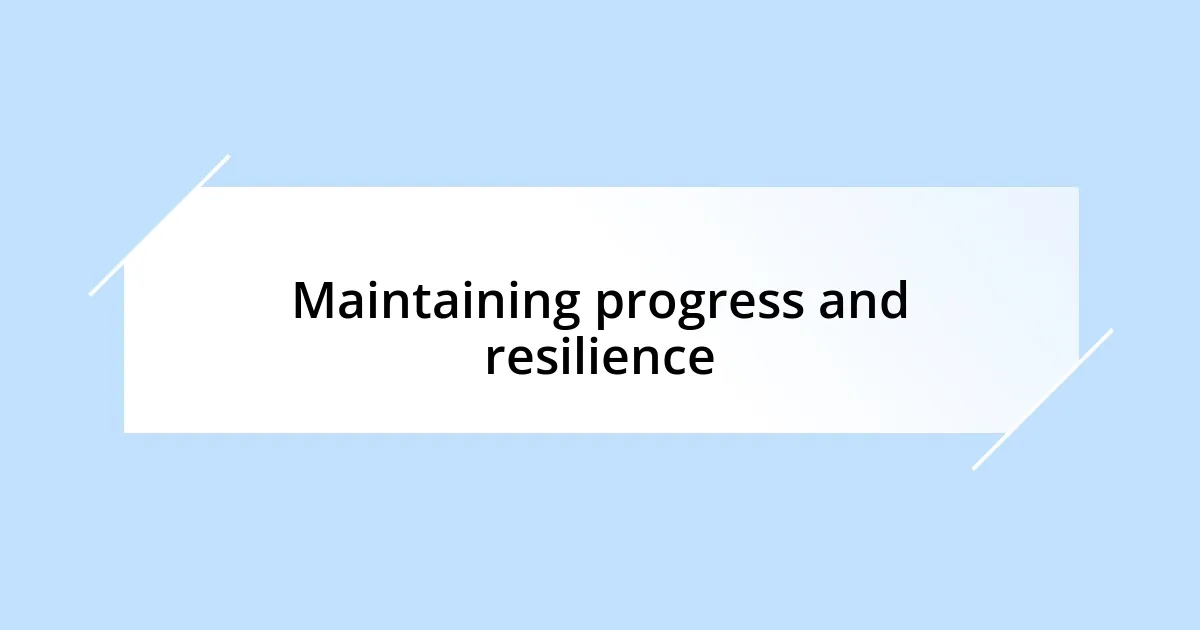
Maintaining progress and resilience
Maintaining progress can sometimes feel like navigating a rollercoaster. I remember a period when I faced setbacks that made me question my journey. There was a day when I stood at the foot of a hiking trail, feeling overwhelmed by anxiety about the steep hike ahead. I almost turned back, but a friend encouraged me to take it one step at a time. That supportive nudge reminded me that it’s perfectly normal to experience ups and downs along the path to overcoming fears.
Resilience is often built in the quiet moments of self-reflection. After those challenging experiences, I made it a habit to check in with myself. I would ask, “What did I learn from this setback?” One time, during a particularly nerve-wracking situation, I realized my fear had less to do with the event itself and more with my anticipation of it. Identifying this helped reshape how I approached similar challenges. Does reflecting on your experiences ever reveal unexpected insights for you?
To ensure resilience remains a part of your toolkit, I also found that staying adaptable is crucial. There were days when my techniques didn’t work, and I had to pivot my approach. I started exploring alternative methods—like breathing exercises or visualization—not just as throwaways but as essential tools in my arsenal. It brought me comfort knowing that I had options. Isn’t it empowering to know that resilience isn’t about never failing but about finding new pathways when the old ones don’t lead us forward?











